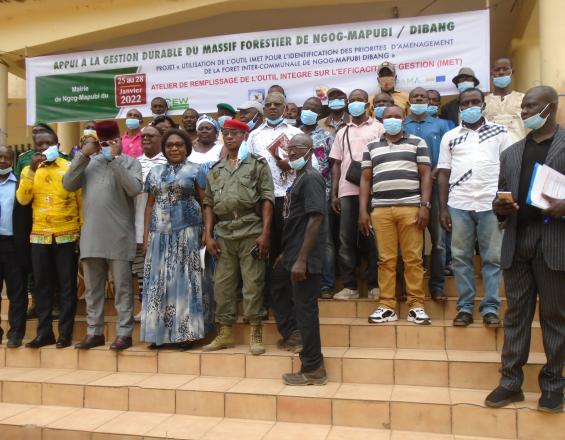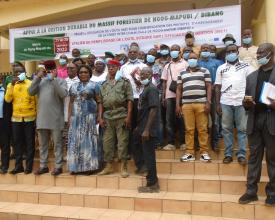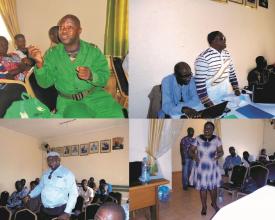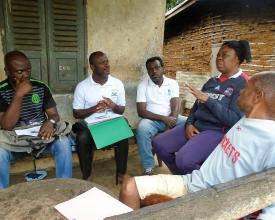
Using the IMET tool to identify management priorities for the Ngog-Mapubi Dibang inter-communal forest

For 10 years, Cameroon Environmental Watch (CEW), with the support of several donors including the European Union, has been working to classify a 14,107 ha forest massif as an intercommunal forest in the Central Cameroon Region, for the benefit of 2 neighboring communes belonging to 2 different and rival political persuasions. Since the classification by decree no. 2018/4175 of May 29, 2018, resources have been sought to produce a management plan. The present BIOPAMA-funded initiative has set out to carry out, for the very first time in Cameroon, an IMET assessment in a communal forest (outside conventional protected areas) with the aim of identifying management priorities prior to drawing up the management plan. Using IMET as a dialogue tool, we identified 3 priority areas for action.
Context
Challenges addressed
Applying the IMET tool to the assessment of communal forests was in itself a major challenge, given that IMET is generally applied to conventional protected areas.
Added to this was the need to bring together two communes belonging to different and competing political persuasions.
Environmental issues: sustainable management of the Ngog-Mapubi/Dibang forest massif.
Socio-economic issues: the massif has potential for socio-economic development, including tourism. The local population would like to see the development process become a reality.
Location
Process
Summary of the process
As the IMET tool was new to the targets, we had to start by raising awareness among the local population and authorities of the benefits of an assessment and the preparation it requires; Once this stage had been completed, we looked for potential channels through which we could reach the IMET coaches, and prepared and launched the call for tender to select (Coach) the person who would conduct the exercise. The next step was to create an administrative and technical framework within which the activities could be carried out; an important provision of this framework was the adoption of an alternative system for holding meetings and activities between the two communes, to promote inter-communality and fairness; the conditions for dialogue and frank debate having been created, the ongoing search for consensus made it possible to identify development priorities and areas in which conflicts needed to be given close attention.
Building Blocks
Raising stakeholder awareness
Discussions with stakeholders to put the project into context and identify the role of each player in order to ensure more effective implementation. A field mission was carried out to meet with local authorities (sub-prefects and mayors), the local administration of the Ministry of Forests and Fauna (MINFOF), local elected representatives, traditional chiefs, local elites and guides.
Enabling factors
- Good historical experience of working on the site
- Practical involvement of local resource people
- The receptiveness of administrative and traditional authorities and local elected representatives.
- Strict enforcement of anti-Covid 19 measures decreed by the administrative authority.
Lesson learned
- Involving local authorities helps to mitigate certain conflicts
- It's essential to reach a wide variety of stakeholders, especially women who are more familiar with the services offered by the forest.
- Be aware that, despite everything, there will always be people who feel they have not been involved; in practice, it is impossible to reach everyone.
Choice of an experienced coach to train and lead the exercise
The choice of IMET Coach was a challenge, given that experts in this field are in short supply. Based on its management procedures, CEW followed a process ranging from the call for applications to the contracting of an IMET expert, a park curator in Northern Cameroon who braved the 700 km distance between his base and the implementation site several times. Thanks to his experience and ability to teach an adult audience, the workshop to fill in the IMET tool went off without a hitch. Organized in the deliberation room of the Ngog Mapubi town hall, the workshop was attended by some thirty people (sub-prefects, mayors, forestry and hunting station chiefs, municipal councillors, communal executives, population representatives, members of the peasant forestry committees, local guides and traditional chiefs from the two arrondissements). During the workshop, discussions were open, ambiguities and concerns were cleared up, and recommendations were collected.
Enabling factors
- Think about launching a competitive tender in time to select the coach.
Lesson learned
Coaches' agendas are sometimes too full, as they have other important duties to perform
- Once the coach has been selected, intensive discussions are held with him/her on the project, planning, the minimum conditions required to carry out the IMET, and the preparation of the players ....
- The open dialogue reassures the stakeholders of their involvement, but is often punctuated by tense phases when the coach uses his experience to calm things down.
- In the end, the exercise is mutually enriching for the actors/stakeholders and also for the coach, who learns to adapt the tool to a communal forest.
Adoption of an alternative system for holding meetings and activities between the two communes
The forest is supposed to be managed by a joint community. As the two communes are political rivals, belonging to 2 different political persuasions (one run by the ruling party and the other by an opposition party), it is important to avoid holding all meetings and events in a single commune. Each commune must be able to organize and host the other in an alternative way. The strategy of alternating the holding of meetings in the two communes helped to encourage participation, with the support of the administrative and municipal authorities.
Enabling factors
- The existence of a decree creating the forest and the geographical proximity of the two communes, which belong to the same administrative department.
- the pride shown by the players in each commune in having the responsibility of hosting the activity and welcoming all the others.
Lesson learned
- The alternative system ensures intercommunality and fairness
- This system ensures that awareness of the importance of sustainable forest management is constantly reinforced in both communes.
Dialogue and identification of priorities
This is the result of a multi-phase process:
-
A phase of exchange with municipal players;
-
A community work phase;
-
A phase of analysis and processing of the information collected;
-
Presentation of the information collected in workshops, exchanges and integration into the IMET tool whenever consensus is reached;
-
Restitution of results generated by IMET to stakeholders.
Enabling factors
- Freedom of speech, enabling all stakeholders to express themselves, even if they are not happy.
- The constant search for consensus
- Transparent on-screen completion of the form when consensus has been reached, allowing everyone to see the information entered.
- Plenary commentary on results presentation graphs
Lesson learned
- Coaches are sometimes overloaded with other important duties.
- Once the coach has been selected, intensive discussions are held with him/her on the project, planning, minimum conditions required to carry out the IMET, preparation of the players ....
- Open dialogue reassures stakeholders of their involvement, but is often punctuated by tense moments when the coach uses his experience to calm things down.
- In the end, the exercise is mutually enriching for the actors/stakeholders and also for the coach, who learns to adapt the tool to a communal forest.
Impacts
- Local stakeholders discover IMET
- Experimentation with IMET in another conserved or managed area
- The National Park Conservation Coach, used to IMET in the National Park, learns to adapt it to a communal forest and finds the initiative original.
- Areas of consensus and conflict highlighted
- Priorities for action and management identified
- A new project has been drawn up based on the priorities identified for follow-up.
Beneficiaries
Communes, local elected representatives, administrative and traditional authorities, women's groups, local guides, Dibang and Ngog-Mapubi communities, including technical staff from the same communes.




